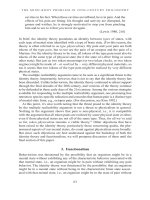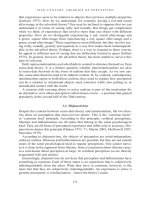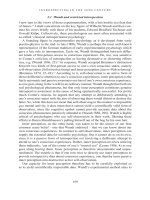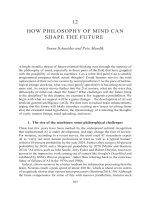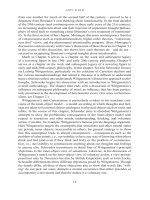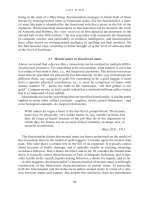Philosophy of mind in the twentieth and twenty first centuries the history of the philosophy of mind volume 6 ( PDFDrive ) (1) 130
Bạn đang xem bản rút gọn của tài liệu. Xem và tải ngay bản đầy đủ của tài liệu tại đây (170.14 KB, 1 trang )
2 0 th - century theories of perception
that experiences seem to be relations to objects that can have multiple properties
(Jackson 1975). How do we understand, for example, having a red and round
after-image in the adverbial theory? One may be inclined to suppose that we can
understand it in terms of seeing redly and roundly. But things get complicated
when we think of experiences that involve more than one object with different
properties. How do we distinguish experiencing a red, round after-image and
a green, square after-image from experiencing a red, square after-image and a
green, round after-image? These experiences seem different, but they involve seeing redly, roundly, greenly and squarely in a way that makes them indistinguishable in the adverbial theory. Perhaps, there is a way to respond to these worries
by appeal to different acts of seeing that are differently located in space (Sellars
1975). In general, however, the adverbial theory has been unable to survive this
type of criticism.
Both representationalists and adverbialists wanted to distance themselves from
sense-data theory. It is a further question whether representationalists are akin
to sense-data theorists in the form of realism that they accept. As we saw earlier, sense-data theorists tend to be indirect realists. If, by contrast, contemporary
intentionalists aspire to hold direct realism, they need to explain how perception
can be a relation to intentional objects (and contents) while also putting us in
unmediated contact with the world.
A concern with rescuing direct or naive realism is part of the motivation for
an alternative view about perception called disjunctivism – a position that gained
popularity in the second half of the 20th century.
1.4 Disjunctivism
Despite the contrast between sense-data theory and intentionalism, the two theories share an assumption that disjunctivism denies. This is the ‘common factor’
or ‘common kind’ principle. According to this principle, veridical perceptions,
illusions and hallucinations are all states that belong to the same psychological
kind. They are all forms of perceptual experience that differ only in accuracy. Disjunctivism denies this principle (Hinton 1973, 71; Martin 2003; McDowell 1987;
Snowdon 1979).
According to disjunctivism, the objects of perception are mind-independent,
ordinary entities. Illusions and hallucinations are possible, but they are not mental
states of the same psychological kind as regular perceptions. One cannot move,
as it is done in the argument from illusion, from a conclusion about illusory cases,
to a conclusion about perception at large. In veridical perception we are directly
acquainted with real entities.
Interestingly, disjunctivists do not deny that perception and hallucination have
something in common. Each of these states is an experience that is subjectively
indistinguishable from the other. What they have in common, however, is the
mere fact that they are subjectively indistinguishable. An experience is either a
genuine perception or a hallucination – hence the theory’s name.
111

